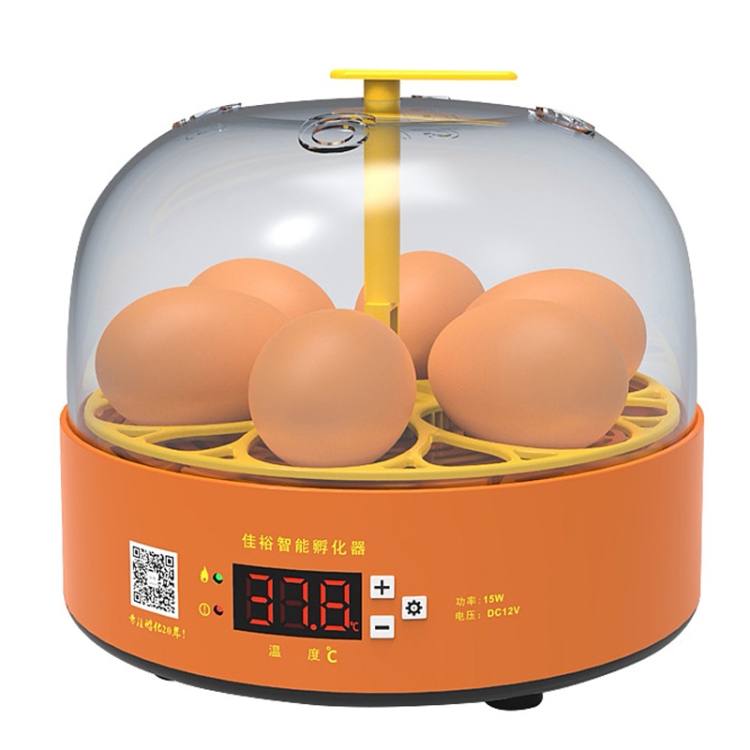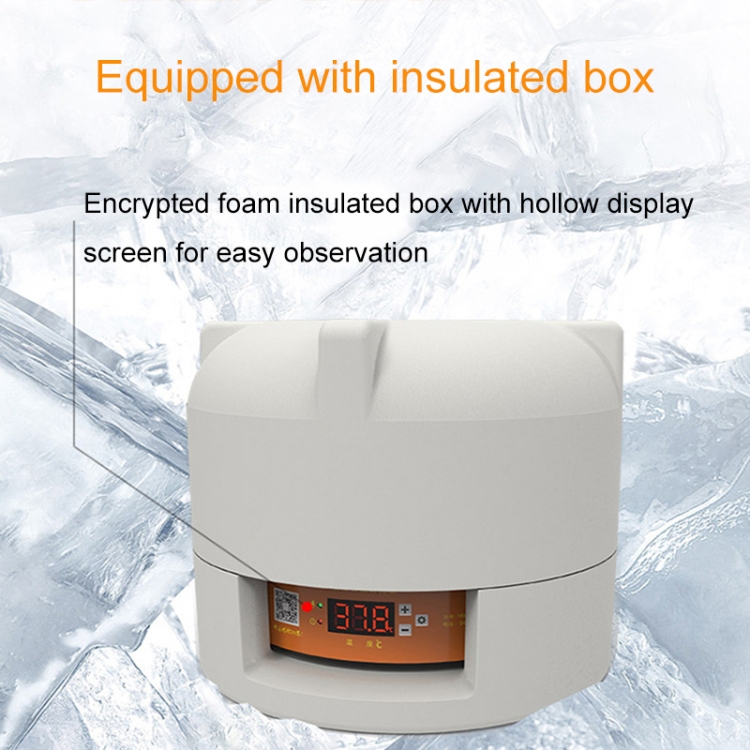6-Eggs Small Household Experimental Children Smart Chicken Incubator (Manual EU Plug) — A Smart Start to Poultry
Tired of Curve Flattening- Time for Home Incubation
Incubating your own poultry birds can be an incredibly rewarding experience, and the excitement of watching life emerge from a simple egg has been the catalyst for many to step into the world of poultry incubation. Nowadays, as more people become interested in self-sustainability, organic food sources, and hands-on forms of education, incubators are popular among households, educators, and even hobby farmers. The 6-Eggs Small Household Experimental Children Smart Chicken Incubator is just right for entry-level people who want minimalism but also functionality and education. Its approachable design makes it great for children, students, and families interested in discovering science through playful interaction. It also aids the basic poultry projects of homesteaders who want to hatch a few chicks to fill their backyard coops without shelling out money for a commercial incubator.

The Art of Small: Build and Volume
This incubator is small but mighty when it comes to functionality. Only a few inches high and wide, it is meant to rest on just about any flat surface, be it a kitchen counter, a classroom table or a home laboratory. With a capacity of up to six eggs, this is a perfect number for personal use or educational demonstration purposes. This limited capacity allows you to cover each egg individually that means each egg receives real attention and less chance of failing to join the temperature flow. One thing we really like is the clear dome lid—you get to see everything progress to hatching without needing to open the unit, ensuring a stable environmental inside the unit. The inner egg tray is shaped to cradle each egg closely, with minimal rolling or jostling that could harm developing embryos.
Manual: Promoting a Do-It-Yourself Approach
You'll notice that this incubator is also much, much more manual— users have to turn the eggs individually several times a day. This replicates how a brooding hen goes about her business of turning each egg, instinctively making sure that no one developing chick is behind the others. And while manual turning may be seen as a downside, it’s actually an amazing chance to teach — especially for kids. If users are turning eggs manually, it allows them the chance to create a routine, see the physical changes, and learn how a chick needs to balance itself to hatch successfully. It also creates a sense of responsibility, as the egg needs to be turned regularly, to prevent the embryo from sticking to the shell membrane. This task, in a nutshell, transforms the incubation process into an interactive, tactile experience that extends well beyond passively watching.

Smart Temperature and Humidity Control Features
Although this specific model is operated manually, it does come with a few smart features that streamline the process and ensure the results are accurate. The internal heat significantly matters to a successful incubation, that's why users can be able to monitor it continuously by means of digital LED temperature display. For proper development over the period of 21 days, chicken eggs require an even temperature of around 37.8 degrees Celsius (100°F). An adjustable thermostat allows you to adjust it up or down if they fluctuate, and many units come with either an automatic shut-off or overheat protection feature to prevent damage. A few iterations even include integrated humidity markers or a water channel tray to help keep the moisture levels just right. Proper humidity is critical, at about 50-55% for the first 18 days and 65-70% for the final 3 days, since this allows the chick to pip and hatch properly. These semi-smart controls bolster users’ ability to manage the delicate balance of heat and humidity with confidence.
Helpful for Children with Learning Experience
The most attractive part of this incubator is the educational aspect. It’s a thrilling but very instructive experience to watch the development of a chick emerge from an egg. It teaches children about biological science, life cycles and environmental control in a way that textbooks could never hope to replicate. Every day is a new exercise in watching and learning — from candling the eggs to see what’s inside them to recording changes in temperature and humidity to finally watching the chick pecking its way out of the shell. In addition, the incubator fosters lessons in responsibility, teamwork and patience as it is used in classroom environments or group projects. It is a perfect tool for science teachers, homeschoolers and parents hoping to combine practical skills with academic curiosity.”
Compatible Electric Plugs in the European Union
Includes Manual EU Plug for Standard European Voltage (220–240V) This means, in those countries, no adapter is needed to use it safely. Safety features are also integrated into the design. The power cord is insulated and firmly attached, while the body is crafted from heat-resistant, non-toxic plastic. The base is also flat and stable to avoid tipping or sliding. Though the incubator is kid-friendly, it remains an electrical device, so adult supervision is highly suggested, especially when it comes to adding water for humidity, adjusting temperature settings or handling newly born chicks. It’s best for dry, indoor environments where it will be protected from moisture or direct sunlight.
Suitable for Beginners and Hobbyists
This incubator is a perfect starter model for those entering poultry keeping — and educational hatching — for the first time. Unlike more complicated and pricey incubators with automatic controls, this unit is affordable and easy to use. It is eco-friendly; the compact size reduces waste and energy consumption. Though ideal for schoolchildren and educators, it also attracts urban homesteaders or small-scale poultry producers who want to experiment with hatching chickens, quails, or ducks in controlled batches. The transparency of the lid, the intuitive control of temperature and the manual turning of the eggs work together to create an experience that by turns, is useful and delightful and informative, as well as producing results.

Conclusion
Few miracles are as magnificent as the journey of life, and the life of a chicken does not take long if you experience it up close rather than through a glass screen (6-Eggs Small Household Experimental Children Smart Chicken Incubator (Manual EU Plug)) Green tomatoes was designed to be simple and educational, so not just an incubator, but a powerful bridge between science, sustainability and nature. For families, it becomes a bonding experience as parents and children collaborate to create the ideal environment for new life. For educators, it is a living laboratory of science, making theory tangible and textbooks come to life.
This compact incubator finds a happy medium between manual intervention and smart technology. In requiring users to turn the eggs they have themselves, it encourages a deeper understanding of the incubation process, underscoring the need for consistency, care, and patience. Meanwhile, the built-in digital temperature controls and transparent observation window make it all easy to track, both educational and manageable. The novel solution this device provides makes it perfect for classrooms, homeschooling, and small-scale poultry keeping.
What makes this incubator unique is its emphasis on hands-on involvement. In addition to biology and life cycles, children learn responsibility, time management, and the fulfillment of raising a living thing from beginning to end. Every stage in the incubation cycle serves as a lesson—how to control humidity, check temperature, turn eggs, and, finally, how the chick comes into the world. These are moments that elicit curiosity and excitement, forming memories that last a lifetime as well as a deeper appreciation for how fragile and breathtaking life is.
Practically speaking, the incubator are safe, energy saving and space savings. Compatible with EU electrical standards, it finds applications in diverse households and institutions. And while it’s simple enough for first-timers, it’s also reliable enough for experienced hobbyists looking for a no-frills, effective solution for hatching small batches. Or, if you are hatching chicken eggs for the first time or teaching embryology to a class of students, this model delivers consistent results without becoming overwhelming.
In a world dominated by screens and instant gratification, this incubator returns learning to its origins — kitschy within the actual world and really context. The process of life unfolding, of a tiny chick emerging from its shell after weeks of protection and nurturing, is awe- inspiring and connects us deeper with the natural world; with a cycle of which we are a part.

